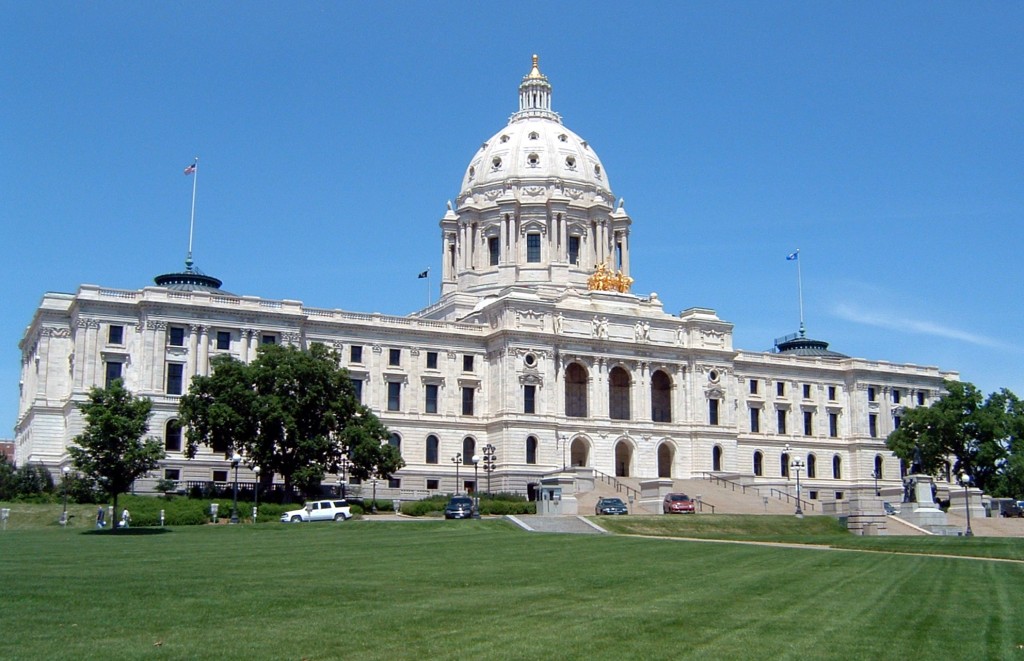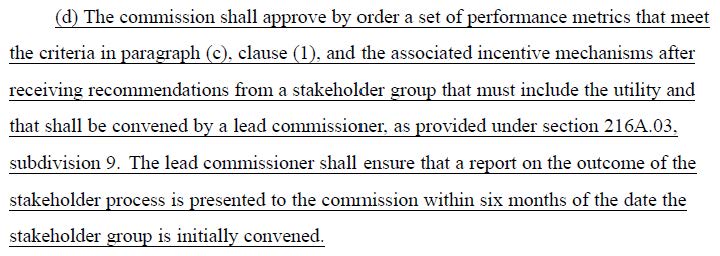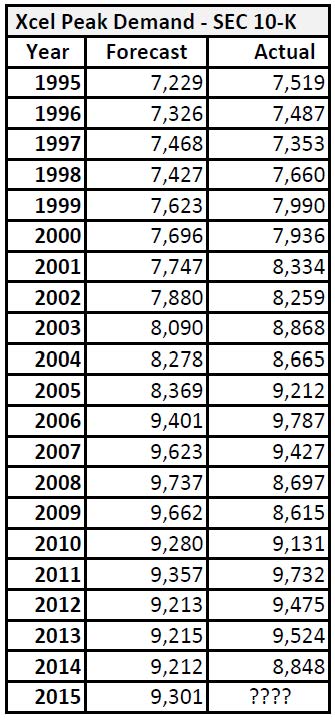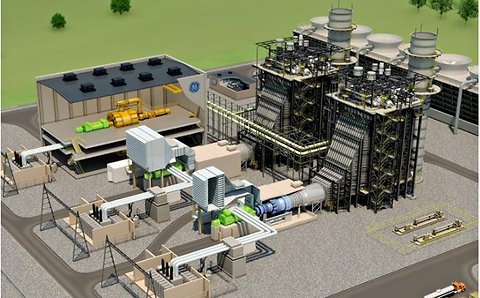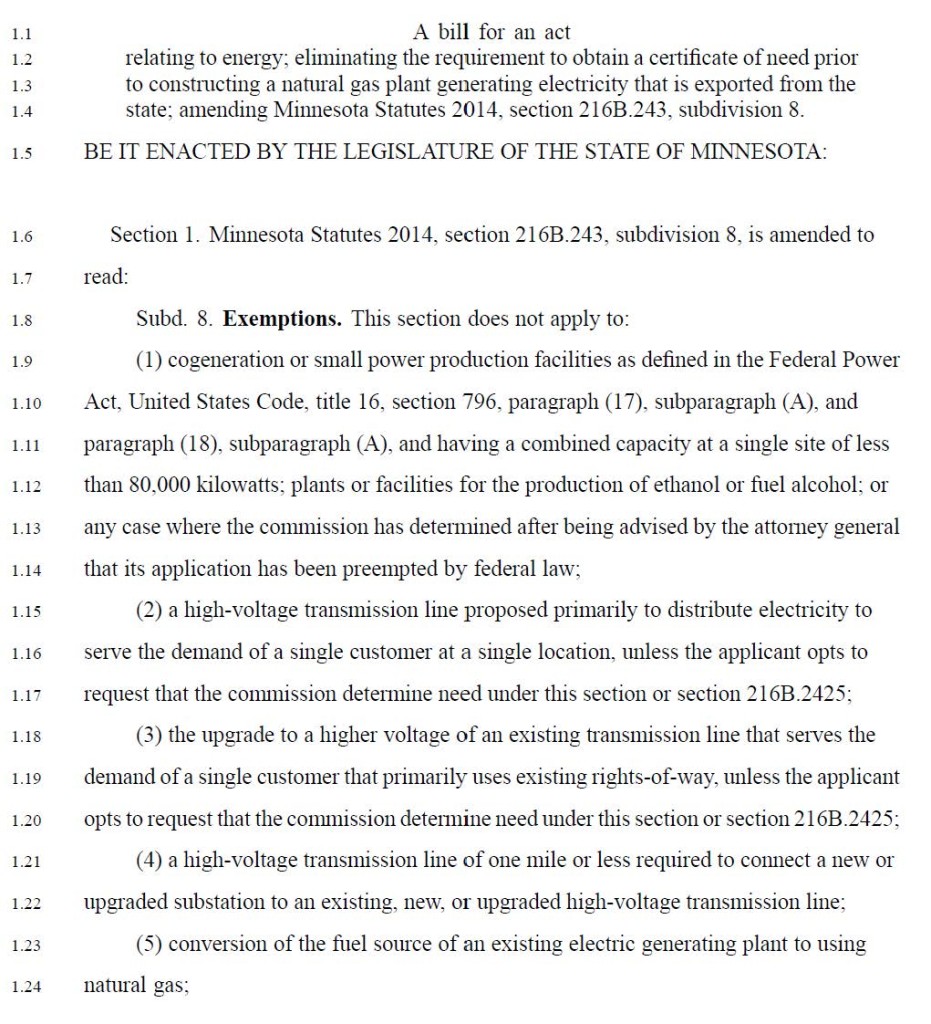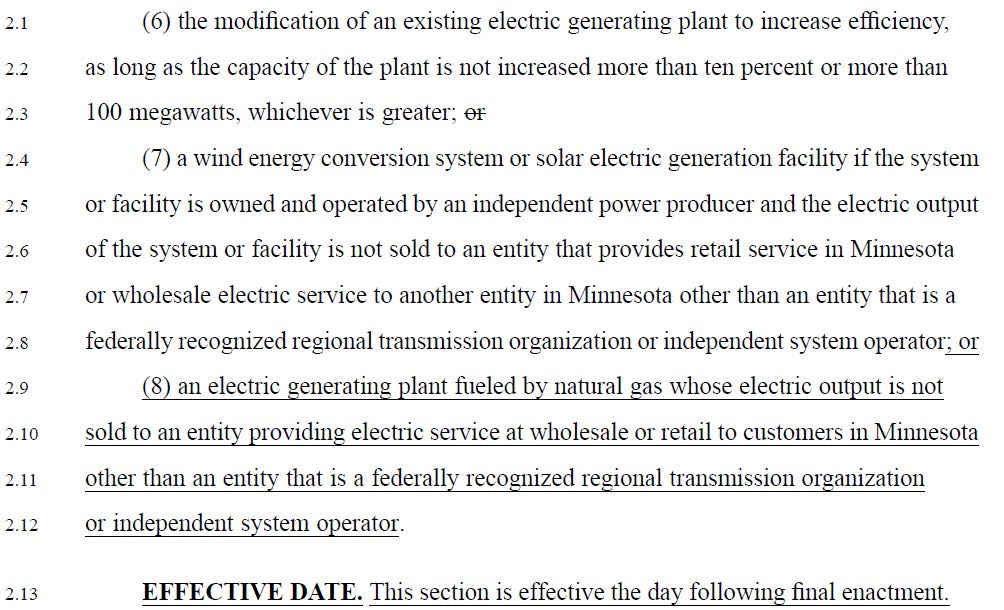Freeborn Wind Responds & AFCL Replies!
October 5th, 2017

Oh my, seems that Association of Freeborn County Landowners has struck a nerve. Freeborn Wind Energy (Invenergy) has responded:
Here’s the Response of AFCL to that Reply:
Reply_Association of Freeborn County Landowners_Petition for Task Force
There are some pretty wild statements, attributing motives and purposes that are off the wall:
- Apparently, aware that a task force could not meet its traditional statutory duties, AFCL argues for the creation of a new purpose — that such task force should be appointed to help resolve contested factual issues. Response, p. 7.
- AFCL appears to be seeking and Advisory Task Force that would persist through the contested case proceeding. Response, p. 8.
- AFCL’s request for a Scientific Advisory Task Force is, quite transparently, a second try to commence a rulemaking relating to wind turbine noise. Response, p. 8.
Oh my… Here’s the statute, and a review of that demonstrates that the first two of their presumptions are contrary to law, and ya know, there are some lawyerly rules (Rule 11 anyone?) against those types of arguments misrepresenting the law:
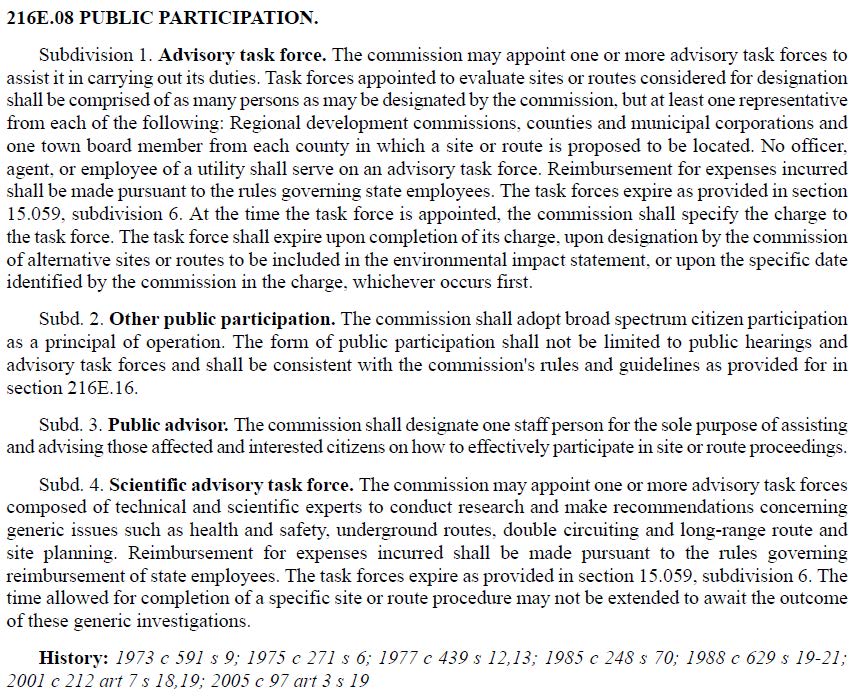
“AFCL argues for the creation of a new purpose?” No. The only purpose specified in the statute, but stated in a way that leave it open to other purposes, is one of “evaluating sites.” That’s in the second sentence of Subd. 1. What typically happens in a task force is that the application is reviewed, members comment on it and raise issues and proposed additional options. That’s called informing the record. That’s what task forces do, contribute their first hand knowledge of their community, and use that to evaluate sites, to propose alternate sites (which should be in the application but are not!). The charge is to be specified by the Commission.
“Persist through the contested case proceeding?” After the Chisago I task force, which intervened in the first Chisago contested case, Northern States Power made sure that wouldn’t happen again, and in 2001 pushed to get language into the statute that did exactly that:
The task force shall expire upon completion of its charge, upon designation by the commission of alternate sites or routes to be included in the environmental impact statement, or upon the specific date identified by the commission in the charge, whichever occurs first.
Minn. Stat. 216E.08, Subd. 1. DOH! No way can the task force “persist.”
“AFCL’s request for a Scientific Advisory Task Force is, quite transparently, a second try to commence a rulemaking relating to wind turbine noise.” No. I’ve filed a lot of rulemaking petitions over the years, and even more petitions for task forces. With the 2016 petition to the MPCA for rulemaking on wind noise, the Commissioner said that there wasn’t sufficient “understanding of wind turbine noise and its potential effects” for rulemaking:

Soooooooo, if there is insufficient understanding, how do we build that understanding to the point its sufficient to support rulemaking, how do we “monitor the science” for a decision regarding future rulemaking? Yes, seems to me this is what a Scientific Advisory Task Force is for! And it’s my belief that the last time this was done was the Stray Voltage report from the “Science Advisors”back in the ’90s, appointed by the Public Utilities Commission to consider stray voltage:
This report came up several times in the Arrowhead Transmission Dockets in Minnesota and Wisconsin, and was not at all helpful in advancing understanding of stray voltage, that took a few successful plaintiffs, like Zumberge and Cook in Minnesota, but this is a way to develop the record. Worth noting is that this Science Advisors report was before Freeborn Energy’s attorney Lisa Agrimonti’s time… though I know Mike Krikava would remember!
I have a rulemaking petition for both Minn. R. Ch. 7030 and Ch. 7854 on deck, but as far as I can see, nothing has changed in MPCA’s “understanding” of wind noise and impacts on human health. We need to get the information into the system somehow. A Scientific Advisory Task Force — that is why this statute was created, that’s the purpose! DOH!
The Response of Freeborn Wind Energy has zero credibility. Did they make these arguments up while sitting around the bar after the Line 3 hearings last week? Good grief…
WRAO & WIRES docs removed from ATC site
September 18th, 2016
Here’s to preservation, download quick to have this bit of history:
| WRAO Report on Transmission System Reinforcement in Wisconsin | File Size | Document |
| Letter of Transmittal to PSCW | 22.8KB | PDF: 1 page |
| Report (without attachments) | 256KB | PDF: 33 pages |
| Attachment A1 – WIREs Phase II Study Report | 391KB | PDF: 79 pages |
| Attachment A2 – WIREs Phase II Study Report (AppendixB) | 2,181KB | PDF: 100 pages |
| Attachment B – Environmental Review of Phase II WIRE Study for the WRAO
Study area map (summary_map.jpg) 1C Salem – Fitchburg – NorthMadison/Rockdale Analysis 2E Prairie Island – La Crosse – Columbia Analysis 3J Arrowhead – Weston Analysis 5A&B Chisago-Weston (345 kv) & Apple River – Weston (230 kV) Analysis 9B Lakefield Junction – Adams – Columbia Analysis 10 King – Eau Claire – Weston Analysis |
– | Web Page |
| Attachment C – Wisconsin’s Electric Transmission Interconnection Capacity Requirements | 120KB | PDF: 15 pages |
| Attachment D – White Paper on the Requirement for Geographic Diversity in Transmission Line Route Selection for System Reliability | 5,910KB | PDF: 41 pages |
| Attachement E – Stakeholder Comments | 188KB | PDF: 70 pages |
Comments due on Tiller… errr… Titan Lansing sand plant
August 19th, 2015
Air Permits at the MPCA! Time to sit right down and write a Comment to the MPCA about the Titan Lansing sand processing and loading facility in North Branch. Scroll down for the primary documents.
Send Comments, by Friday, August 28, 2015, to:
Andrew Luberda
email: andrew.lubera@state.mn.us
Air Quality Permits Section Industrial Division
MN Pollution Control Agency
520 Lafeyette Road North
St Paul MN 55155
The notice does not list an email for Luberda or a MPCA comment url, so I called him up to get his email. I asked if they’d correct this omission, and got a non-responsive response.
Tiller Sand transloading facility… If you recall, this was that Tiller Sand facility that they built and started operating WITHOUT ANY PERMITS, just went ahead and did it. That said, their history isn’t exactly as pristine as… well… as pristine as frac sand!
January 25, 2013 – Tiller Corp. is penalized for air-quality violations
November 20, 2014 – Tiller Corporation penalized for air-quality violations
Then it was sold to Titan Lansing in November 2014 (see comments about air quality and permits in this article).
In the Chisago County Press here’s the poop about the MPCA Air Permit and info on how to file a Comment, great info about various Comment and administrative options (not that the MPCA ever does contested cases):
Here’s the scoop from the Minnesota Pollution Control Agency:
Open for public comment through Friday, August 28, 2015. Send Comments to:
Andrew Luberda
email: andrew.lubera@state.mn.us
Air Quality Permits Section Industrial Division
MN Pollution Control Agency
520 Lafeyette Road North
St Paul MN 55155
the problems with SF 1735…
March 18th, 2015
Please say no to S.F. 1735, a bill that would result in removal of the regulatory protections for rate-payers and the public, and let utilities have the ability to charge us for private costs, and costs that have not been demonstrated to be prudent expenditures.
Little by little, Xcel Energy’s e21 Initiative is slithering into bills before the House and Senate Energy Committees.
Before anyone can vote on these bills, they should read Alfred Kahn’s “The Economics of Regulation,” both Volume 1 and Volume 2.
What’s e21 Initiative? Here’s what Xcel filed at PUC, docket 14-1055:
Tomorrow, S.F. 1735 (see companion HF 1315)and S.F. 1431 are in Committee, and they’re supposed to vote on the Energy Ominous bill.
What’s up with S.F. 1735? Well, check out this version, with yellow highlighting (and this is NOT all-inclusive):
SF 1735doesn’t have the part about “Competitive Rate for Energy-Intensive Trade-Exposed Electric Utility Customer” part that HF 1315 does, though we’ll see what the mines and Koch Refinery have to say about that when the Energy Ominous bill comes together and everyone has their hand out and foot in the door.
SF 1735 is a problem because… where to start… the first problem is that it proposes, as Xcel does in e21, a BUSINESS PLAN which “replaces a general rate case filing,” REPLACES! The standard it must meet is that it result in “just and reasonable rates,” and there’s nothing about “prudent” and there’s nothing about being in the public interest. DOH!
And dig how it would be approved — they SHALL approve:
Stakeholder group… right, we know who that is, and we sure know who that isn’t! And that’s the e21 Initiative mantra, stakeholders, and from who was included in e21, we know who would be deemed a stakeholder — all those who have done deals with Xcel Energy! Oh, and DOH, they want approvals at the PUC based on “Settlement Agreements.” Right, like the one that opened the door and welcomed CapX 2020 transmission, and that horriffic “it’s a deal, it’s a package deal, and it’s a good deal” of the 2005 Ch 97 – Transmission Omnibus Bill from Hell with Xcel transmission perks, CWIP and C-BED :
PUC decision based on “stakeholders” and deals with Xcel Energy? No, I think not.
Per the House hearing on HF 341 (see also S.F. 237), Minnesota should now be an electricity exporter, which is one between-the-lines goal of e21 Initiative, the others being ability to build without demonstrating need, to use ratepayer money for market development, to eliminate contested cases and use “Settlement Agreements,” which they’ve done expertly in the past. Exporting for profit is doable, now that we have the transmission in place. It would help Xcel Energy to just get rid of that Certificate of Need requirement, which HF 341 would do for natural gas plants of any size, i.e., 800 MW (like the LS Power Sunrise Station proposed for Chisago County, Lent Township) if it’s for sale into the MISO market. As you know, also up for consideration is SF 306 & 536, HF 338, which would lift the nuclear prohibition and allow a CoN for Monticello or anywhere. There’s no need, instead there’s excess generation, but that electricity could also go into the market, and with Construction Work in Progress, Minn. Stat. 216B.16, Subd. 6a, we ratepayers could pay for that private market activity. NO. NO. NO.
NO!
The situation we’re in is NOT new to Xcel or any other utility.
- Distribution system is utility responsibility as franchise holder and regulated utility, but they’ve neglected the distribution system over decades. They have chosen not to upgrade and not to bring it into the 21st Century. That neglect is not ours to correct. Xcel has twice tried to invade and inflict communities with transmission when they had identified a distribution system deficit — Hiawatha and Hollydale. NO!
- Transmission deficit a decade ago was caused by putting so many IPP gas plants on line without requiring transmission upgrades. This is reflected in the TLTG tables for the SW MN 345 kV line, PUC Docket 01-1958. It also became an issue when Big Stone II was proposed because at that time it was “cause cost pays” and they hadn’t been charging gas plants but were going to charge BSII for interconnection costs, and BSII objected (see “standstill agreement” and withdrawal of Bill Gates’ Cascade Investment from that project at Legalectric: Bill Gates & Otter Tail at the PUC Tuesday…). That transmission CoN was denied, approved, and plant was withdrawn so non-issue. Then utilities and paid-for-NGOs went to MISO and FERC to find a way to spread the payment of transmission construction costs around, which they did. The ones building it are not necessarily the ones paying for it, and it’s us ratepayers paying for transmission construction all around the country (See Schedule 26A, MISO Tariff, also Tariff MM) and the PUC has yet to address whether that should be paid for by us — but wait, it’s FERC rates, so the PUC has no say… well, that MISO MVP bill hasn’t come before the PUC yet, and that’s the last thing Xcel wants. That capital cost is for private purpose transmission (market transactions) and as such, it is not ours to pay.
- Generation changed decades ago too, moving away from utility construction and ownership, collect revenue for that, and now it’s morphed to an IPP (Independent Power Producer) mode where a third party takes on risk and cost of construction and sells power to utilities. It’s been that way for decades. Xcel has done some coal plant update, and nuclear update/uprate (grossly over budget by factor of 2+), but no new plants. This shift from that regulated revenue stream was a business choice of utilities, but now they’re looking to make up that revenue that they don’t get for building the plants. That business choice is not ours to “fix.”
- Rates — Utilities want out of rate cases! Of course they’d want that, Xcel has lost ground in their rate demands the last few rounds. A Business Plan is not adequate, however, they need to prove up their expenditures if they expect us to pay them, and we should not, must not, be assessed for their market private purpose expenses, like transmission for export. The bills for CapX 2020 ($2 billion) and for MISO MVP projects ($5.2 billion across Midwest) are the types of large expenses that they do not want to have to justify. Not wanting to go through a rate case is no reason for us to let go of that protective review, or to let them charge us for things that are not public purpose expenditures necessitated by their obligation to provide universal service under their franchise.
- Deregulation — this “e21 Initiative” looks and feels like the 2000 deregulation push to me, particularly with all the support from “environmental” and “advocacy” organizations, well funded, and funded I believe by Xcel and cronies (and that information should be made public). Utilities wanted deregulation (back when Enron and Xcel’s NRG was making 300% profits screwing over California in an orchestrated rate skyrocket) and at that time, Xcel had all the “environmental” organizations behind it as “inevitable restructuring.” Everyone was jumping on the deregulation bandwagon, all bozos on that bus, and that’s how this e21 feels. Lots of people agreeing without knowing what they’re talking about, without understanding the consequences. Back in that earlier deregulation push, the utilities also had everyone on board to pay them “stranded costs” for their large generating plants. Thankfully the A.G. stood up to that pointing out that deregulation is a disaster where ever it goes, and that the claimed “stranded costs” were really stranded assets, and if anyone owed anyone money, the utilities owed us for their assets that were paid for and fully depreciated. Read Corneli on Stranded Assets.
This is not new to utilities. It is not our job to correct their business plan errors, to pay for their neglect, or to finance their market activities.
More on this soon… but the short version, NO to SF 1735. NO to SF 1431.
NO! NO! NO!
It’s not in the public interest.
And by the way, the “WE NEED MORE” histrionic mantra that you year year after year is false. Excess generation? Yes — here’s the peak demand that Xcel Energy has reported on its SEC 10-K filings since 1995:
Also from the 2014 SEC 10-K link:
 |
The question to ask is “What’s stopping utilities?” And it’s not our regulatory system. It’s that utilities are looking for additional ways to transfer their costs to ratepayers without regulatory review.
URGENT – TOMORROW – HF 341 in Committee!
February 24th, 2015
Tomorrow the House Jobs Growth and Energy Affordability Policy and Finance Committee will take up HF 341, see also SF 237, to provide an exemption from Certificate of Need for natural gas plants that sell power into the MISO market.
SAY WHAT?!?!?!
The Power Plant Siting Act, specifically Minn. Stat. 216E.04, Subd. 2(2) already gives natural gas plants a free ride by allowing “alternate review,” which is “review lite.” For example, the “Simon Says” 325 MW natural gas plant that had been planned for Waseca would have been built. The 700-800 MW Sunrise River Station by the Chisago sub would have been built. WHY? Should a community be subject to living with a HUGE natural gas plant without regulation? Nope, no way, no how. Plus who will pay for the transmission interconnection, and how will that be regulated, both “need” and routing… and then there’s eminent domain! What’s the impact on Minnesota utilities and their service territory?
The biggest problem? If it’s not regulated by the PUC, who handles it? Counties. What county has the expertise or resources to review and permit a power plant? Most likely it’s as in Freeborn County, where they cut and pasted the project APPLICATION and called it an EIS! Really! Or look at Chisago County and the Sunrise River natural gas plant. That’s not something that should be thrown at a local government.
Here are the Authors’ emails — contact them today:
rep.chris.swedzinski@house.mn, rep.jason.metsa@house.mn, rep.dave.baker@house.mn, rep.marion.oneill@house.mn
Here are the Committee member emails — contact them today:
rep.pat.garofalo@house.mn, rep.dave.baker@house.mn, rep.karen.clark@house.mn, rep.dan.fabian@house.mn, rep.bob.gunther@house.mn, rep.melissa.hortman@house.mn, rep.jason.isaacson@house.mn, rep.sheldon.johnson@house.mn, rep.bob.loonan@house.mn, rep.jason.metsa@house.mn, rep.jim.newberger@house.mn, rep.marion.oneill@house.mn, rep.peggy.scott@house.mn, rep.erik.simonson@house.mn, rep.dennis.smith@house.mn, rep.chris.swedzinski@house.mn, rep.bob.vogel@house.mn, rep.jean.wagenius@house.mn, rep.jim.knoblach@house.mnPlease let them know how important it is that we continue to regulate natural gas plants. A power plants is large, expensive infrastructure with large, costly impacts, and should only be built when and where needed, after a full Certificate of Need and Siting review.
Here’s an example of how it went in Waseca when they tried to bootstrap a larger plant onto an already approve very small plant — short version? It didn’t go:
Blooming Grove Township — Sen. Dick Day shows his true colors
And in Chisago County where they tried to ram through a HUGE plant on the Sunrise River and pull out large amounts of water — short version? It didn’t go:
LS Power’s Sunrise River plant voted DOWN!
Lent Twp voters say NO! to LS Power
LS Power’s Sunrise River Energy in the news
What about the Mesaba Project which has a site permit good until 2019, and which couldn’t demonstrate either “need” or that it would provide reasonably priced electricity — under this bill, a large natural gas plant could go up on that site without any further review! More info HERE on Mesaba Project!
That’s what communities think of having a natural gas plant using their water, making noise, being lit up 24/7, and all for the profit of some absentee corporate owner: Thanks, but NO THANKS!
Here’s the agenda for tomorrow:
Wednesday, February 25, 201512:45 PM
Room: 10 State Office BuildingChair: Rep. Pat GarofaloAgenda:Overview of natural gas issues in Minnesota.If you wish to testify on HF341, please contact Committee Legislative Assistant, Jonathan Fortner, at jonathan.fortner@house.mn.
Bills:HF341 – (Swedzinski): Requirement to obtain certificate of need prior to construction of a natural gas plant generating electricity that is exported from the state eliminated.

